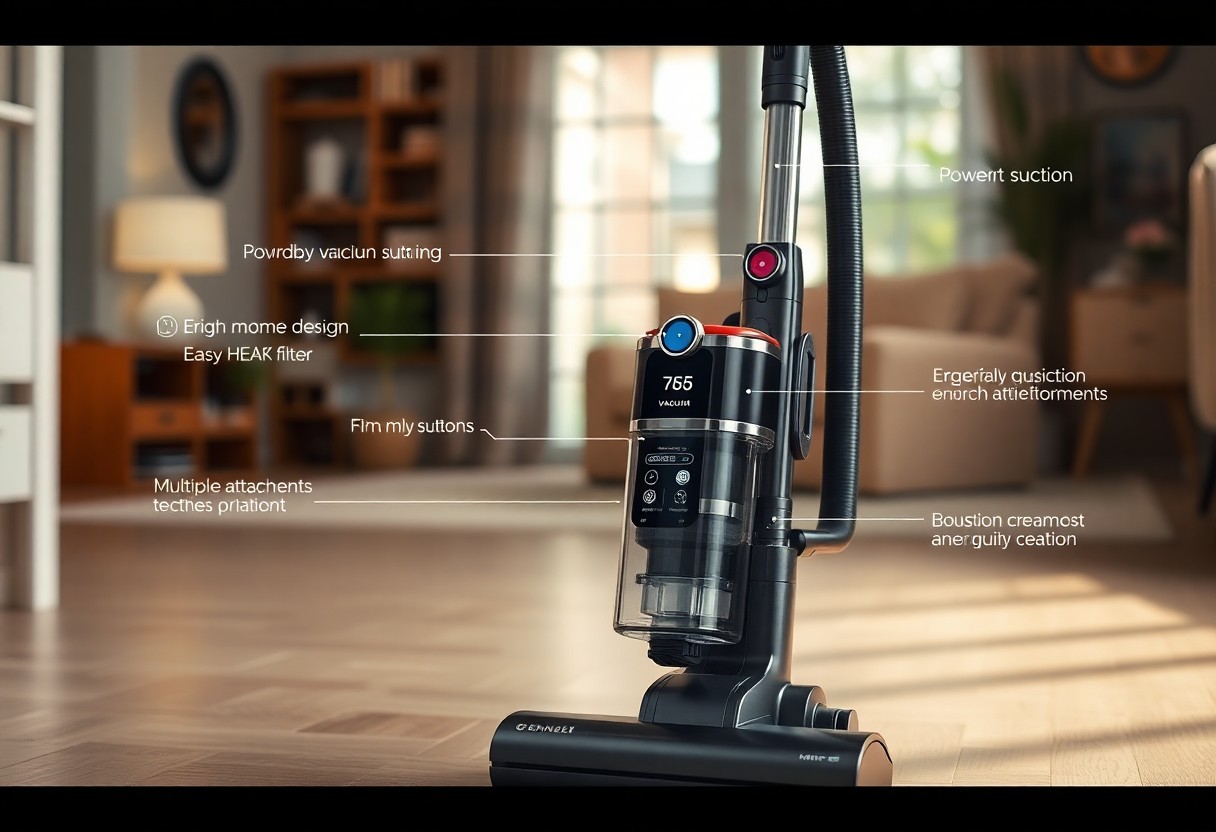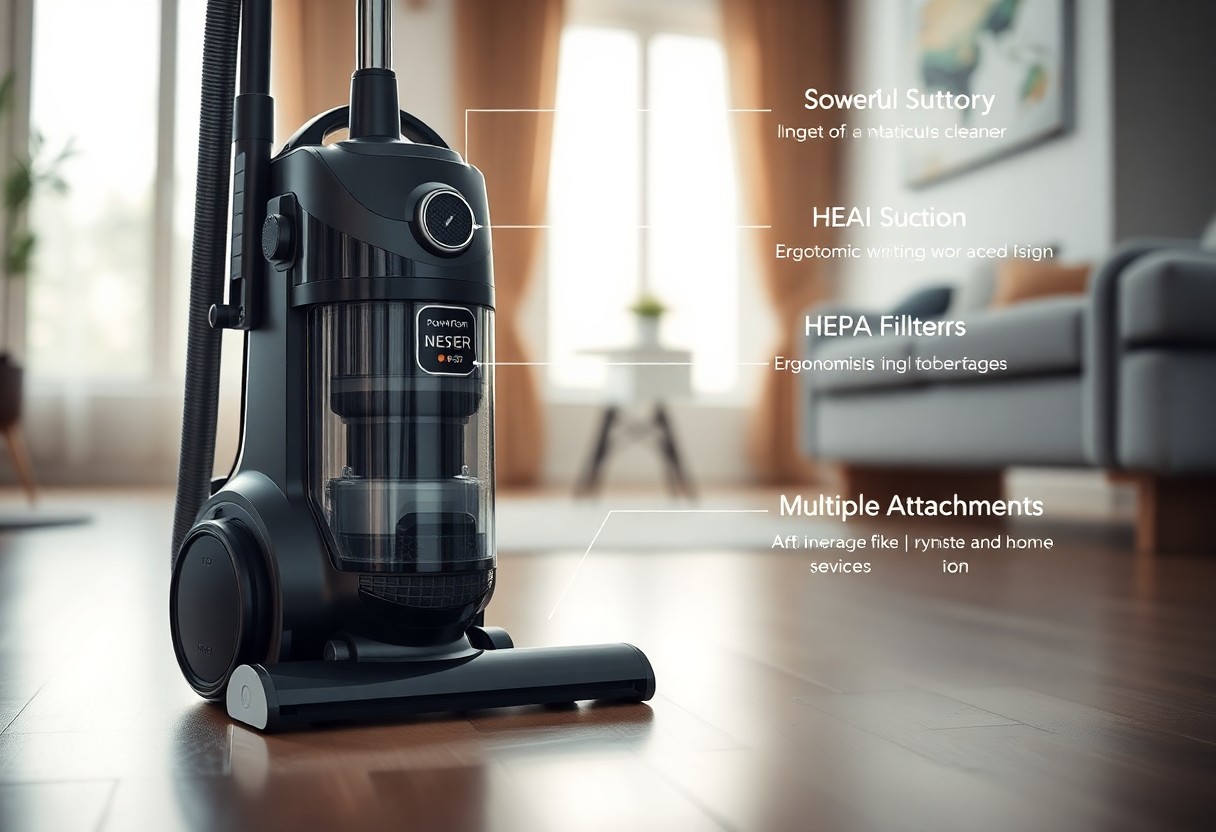Vacuum cleaners come in various shapes and sizes, but choosing one that meets your needs can be overwhelming. To ensure your investment really pays off, there are key features you should consider. By focusing on these top five aspects, you can select a high-quality vacuum cleaner that enhances your cleaning experience and keeps your home spotless. Discover what to prioritize for optimal efficiency, performance, and convenience in your cleaning routine.
Contents
- Suction Power
- Importance of Suction Strength
- Types of Suction Technology
- Filtration System
- HEPA Filters
- Filtration Efficiency
- Maneuverability
- Design and Weight
- Ease of Use in Different Spaces
- Durability and Build Quality
- Materials Used
- Lifespan Expectations
- Noise Level
- Sound Ratings
- Impact on User Experience
- Final Words
Suction Power
While shopping for a vacuum cleaner, one of the most imperative features you should consider is its suction power. A vacuum cleaner’s ability to pick up dirt, dust, and debris directly influences its efficiency and effectiveness. High suction power ensures that your vacuum can tackle various surfaces, from carpets to hardwood floors, leaving them spotless.
Importance of Suction Strength
Among the key factors influencing the overall performance of a vacuum cleaner is its suction strength. A vacuum with strong suction can remove embedded dirt and allergens from carpets and upholstery, contributing to a healthier home environment. When purchasing a vacuum, evaluating its suction capability is vital for optimal cleaning results.
Types of Suction Technology
There are several types of suction technology utilized in vacuum cleaners, each designed to enhance performance. Understanding these technologies can help you choose a vacuum that meets your cleaning needs:
- Single-Motor System
- Dual-Motor System
- Cyclonic Technology
- Bagless Suction
- Water Filtration
Perceiving the differences in these mechanisms can greatly assist in making an informed decision.
| Type of Technology | Description |
|---|---|
| Single-Motor System | Utilizes one motor for both suction and brush roll action. |
| Dual-Motor System | Employs separate motors for powerful suction and dedicated brush actions. |
| Cyclonic Technology | Creates a cyclone to separate dirt from air efficiently. |
| Bagless Suction | Uses a canister instead of bags, allowing for easy dirt disposal. |
| Water Filtration | Utilizes water to trap dirt and dust, providing a deep clean. |
Suction strength is not just about how well a vacuum can pick up debris; it’s also tied to the technology behind it. Different suction technologies cater to specific cleaning challenges, and understanding their distinctions will equip you with the knowledge for the right choice:
- Performance varies based on floor type.
- Cyclonic technology reduces maintenance by preventing clogging.
- Bagless options are more eco-friendly.
- Water filtration systems can capture allergens effectively.
- Dual motors often provide superior performance on carpets.
Perceiving the advantages of each type allows you to tailor your cleaning to best suit your environment.
| Type of Technology | Advantages |
|---|---|
| Single-Motor System | Affordable and lightweight. |
| Dual-Motor System | Offers more robust cleaning capabilities. |
| Cyclonic Technology | Maintains suction over time. |
| Bagless Suction | Cost-effective with no need for replacement bags. |
| Water Filtration | Encourages a healthier living environment. |
Filtration System
Now, when searching for a high-quality vacuum cleaner, pay close attention to the filtration system. A good filtration system not only captures dust and debris but also prevents allergens and microscopic particles from recirculating into your living space. This is especially important if you have pets or allergies. A vacuum with an efficient filtration system contributes to improved indoor air quality, providing a cleaner and healthier home environment for you and your family.
HEPA Filters
Behind the scenes, HEPA (High-Efficiency Particulate Air) filters play a vital role in trapping tiny particles. These filters are designed to capture at least 99.97% of airborne particles that are 0.3 microns in size, including pollen, dust mites, and pet dander. Investing in a vacuum with a HEPA filter ensures that your cleaning efforts do more than just collect visible debris; they significantly improve the air you breathe.
Filtration Efficiency
Beside the type of filters, it’s vital to consider the overall filtration efficiency of your vacuum cleaner. This metric assesses how effectively the vacuum can capture and retain particles without allowing them to escape back into the air. A higher filtration efficiency means a cleaner environment for you, especially as many vacuums can lose suction and release fine dust during operation. Look for models that boast good testing ratings to ensure your investment yields a comprehensive clean.
It’s significant to evaluate filtration efficiency because a vacuum with low efficiency might lead to more dust settling after cleaning, ultimately counteracting your efforts. You want a vacuum that guarantees not only a spotless floor but also fosters a healthier indoor atmosphere. Focus on vacuums that advertise high filtration standards, as they’ll help keep your home cleaner longer, improving the quality of air in your living space.

Maneuverability
Even the most powerful vacuum cleaner won’t serve you well if it’s difficult to handle. Maneuverability is crucial for effective cleaning, allowing you to glide around furniture and reach tight spots with ease. Look for models that feature swivel heads, flexible hoses, and adequate reach to make vacuuming a less cumbersome task. A vacuum that can maneuver smoothly enables you to clean efficiently, ensuring no area is left untouched.
Design and Weight
Above all else, the design and weight of a vacuum cleaner play significant roles in its maneuverability. A lightweight vacuum allows you to carry it up and down stairs effortlessly and from room to room without fatigue. Additionally, consider the design features like compact frames and ergonomic handles, which ensure that you can navigate through your space with ease. When choosing a vacuum, prioritize those that balance functionality with a thoughtful design to enhance your cleaning experience.
Ease of Use in Different Spaces
The versatility of a vacuum cleaner shines when it adapts to various spaces, whether you’re cleaning carpets, hardwood floors, or upholstery. This flexibility allows you to easily transition between different cleaning tasks without needing multiple devices. Models that come with adjustable suction settings and interchangeable attachments are particularly useful for tackling diverse surfaces, ensuring that you achieve optimal results in every corner of your home.
Design is key when it comes to ensuring ease of use across different spaces. Vacuums with features like retractable cords and onboard accessory storage can streamline the cleaning process. Additionally, consider units equipped with specialized attachments, such as crevice tools and dusting brushes, to tackle hard-to-reach areas effectively. Investing in a vacuum that excels in adaptability helps you maintain cleanliness effortlessly in any environment, saving you both time and effort.
Durability and Build Quality
Despite investing in a vacuum cleaner, its performance can be undermined if it lacks durability and build quality. A high-quality vacuum can withstand daily use, providing you with consistent cleaning results. When selecting your vacuum, pay close attention to the materials used and how they contribute to its overall longevity and robustness. This way, you can ensure that your investment pays off in the long run.
Materials Used
Around the design of top-tier vacuum cleaners, manufacturers tend to utilize high-grade materials such as metal and reinforced plastics. These materials not only enhance the build quality but also increase the appliance’s resilience to wear and tear. You’ll want to select a vacuum whose construction reflects durability, ensuring that it can handle the rigors of your cleaning routine.
Lifespan Expectations
Beside the materials used, it’s important to consider the expected lifespan of your vacuum cleaner. A quality vacuum should typically last anywhere from 5 to 10 years, depending on its design and maintenance. You should always be aware of this timeframe, as it helps you gauge when it might be time to invest in a replacement.
Due to the combination of high-quality materials and regular maintenance, your vacuum cleaner can indeed reach or even exceed its lifespan expectations. By taking good care of your device, such as cleaning filters and avoiding overloading it, you can maximize its durability. Investing in a reputable brand also plays a significant role, as reliable manufacturers often design their products to stand the test of time.

Noise Level
After evaluating various vacuum cleaners, one imperative feature to consider is the noise level. A quieter vacuum not only makes for a more pleasant cleaning experience but also allows you to clean at any time without disturbing others. You can explore the 5 Innovative Vacuum Cleaner Features | HowStuffWorks to understand how different models manage sound output.
Sound Ratings
After assessing sound ratings, you’ll find that vacuum cleaners typically range from 60 to 85 decibels. Models with lower decibel ratings are often more desirable, especially if you live in an apartment or have young children. Always check the sound rating to gauge how noisy a vacuum will be in your space.
Impact on User Experience
The impact of noise on your cleaning routine can be significant. A loud vacuum can be off-putting, making the task feel more tedious and less enjoyable. Choosing a quieter model can turn vacuuming into a less disruptive chore and allow you to multitask, like watching TV or chatting with family while you clean.
Even small changes in noise level can enhance your overall experience. A vacuum that operates quietly not only reduces stress but also makes it easier for you to maintain a clean home without the irritation of excessive sound. Opting for a machine with noise-cancellation features can further improve your cleaning environment, leading to a more efficient and enjoyable vacuuming session.
Final Words
Conclusively, when selecting a high-quality vacuum cleaner, you should prioritize features such as strong suction power, versatile attachments, effective filtration systems, ease of use, and durability. By ensuring that your vacuum cleaner meets these criteria, you can enhance your cleaning efficiency and maintain a healthier living environment. Investing in the right model will ultimately provide you with a reliable cleaning companion for years to come.

Leave a Reply